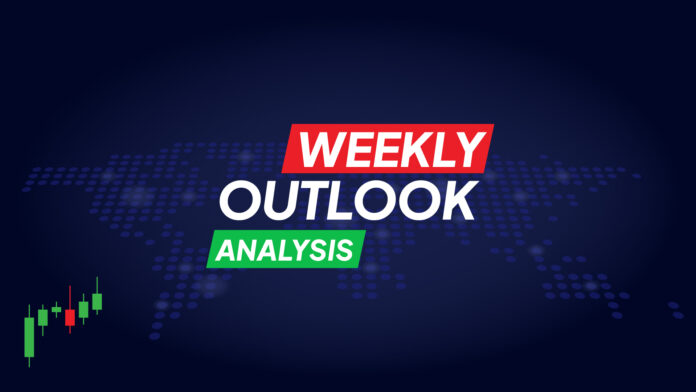Key Points To Watch Out For:
- The dollar awaits more PMI signs to potentially delay Fed tapering.
- Eurozone PMI indices will also be in focus amid speculation of further ECB monetary policy adjustments.
- The pound could benefit from data indicating a pickup in inflation.
- Canadian and Japanese CPI figures will be key highlights.
Trump Election Raises Bets on Fed Pause
The U.S. dollar continued to show signs of strengthening for another week, with the so-called “Trump trades” remaining resilient. This is largely due to the president-elect’s Republican Party holding control of both houses of Congress, providing significant leverage for Donald Trump to transform his campaign promises into law.
The newly elected president has proposed massive corporate tax cuts and tariffs on imported goods, particularly from China—measures perceived by the financial community as inflationary. Consequently, this could prompt the Fed to delay future rate cuts.
With U.S. CPI-related data indicating tightening price pressures in October and Fed Chairman Jerome Powell remarking last week that there is no need to rush into lowering interest rates, market participants increasingly believe the central bank may adopt a more cautious approach. Current probabilities suggest a 37% chance of a pause in December and a 57% chance of a similar outcome in January 2025.
Will PMIs Warrant the Fed’s Pause?
This week, U.S. currency traders should closely scrutinize the preliminary S&P Global PMI data for November, due on Friday, November 22, to assess whether the U.S. economy’s condition might allow Fed officials to slow the pace of rate cuts.
The sub-index of prices charged will likely attract significant interest, as traders look for signs of whether October’s tight pricing trends persisted into November. Confirmation of such trends could increase the likelihood of a Fed pause in January, potentially driving an uptrend in both Treasury yields and the U.S. dollar.
Euro Also Awaits PMIs Amid Tariff Uncertainty
On the same day, ahead of U.S. data, S&P Global will release PMI indices for the eurozone and the UK for November. Better-than-expected eurozone third-quarter GDP data and a rebound in CPI inflation in October have reduced expectations of a 50-basis-point rate cut by the ECB in its next decision.
However, concerns that increased tariffs under the Trump administration might impact the eurozone economy have rekindled speculation about bold ECB action in December. These concerns have contributed to the euro falling to more than one-year lows.
Even if PMIs point to slight improvement in business activity, worries about the impact of U.S. policies and ongoing uncertainty in Germany’s political landscape could limit a euro rebound. The prolonged process of forming a new German coalition government could delay trade negotiations with the U.S., adding to the euro’s challenges.
Will British CPI Show the First Signs of Recovery?
In the UK, the most important data for pound traders will be released before the PMI on Friday, November 22. CPI data for October is due on Wednesday, November 20, followed by retail sales figures on Friday.
The Bank of England recently cut interest rates but signaled caution about the pace of further easing, leading to a delay in market expectations for another rate cut. Currently, there is only an 18% chance of a December reduction, while a quarter-point cut is expected in March next year.
September’s headline inflation rate fell to 7.1% year-over-year. However, investors are paying close attention to the underlying rate and the BoE’s upward revisions for next year, from 2.2% to 2.7% year-over-year.
If Wednesday’s CPI data shows signs of increasing price pressures, investors could further delay expectations for the next rate cut, potentially boosting the pound. This effect would be amplified if Friday’s retail sales data also delivers positive surprises.
Conclusion
More CPI figures are set to dominate this week’s economic calendar. Canadian data will kick off the week on Tuesday, November 19, culminating with Japan’s CPI release on Friday, November 22. There is a 35% chance that the Bank of Canada will cut rates by 50 basis points in December. October’s employment data was mixed, with the unemployment rate steady at 6.5% instead of rising to 6.6% as expected. However, the net change in employment slowed more than anticipated. This was insufficient to prevent the Canadian dollar from falling against the U.S. dollar, with USD/CAD trading at levels not seen since May 2020.
The headline CPI came in at 1.6% year-over-year in October, while the trimmed CPI remained flat at 2.4%. Further cooling could strengthen the case for a December rate cut, likely pressuring the Canadian dollar further. The Bank of Japan left interest rates unchanged on October 31 but suggested conditions are ripe for potential increases. The yen’s recent depreciation has convinced many market participants of possible rate hikes—13 basis points in December and 20 basis points in January. However, even if the CPI release on Friday confirms these expectations, any recovery in the yen may be limited given the U.S. dollar’s strength and pre-existing rate hike assumptions.



